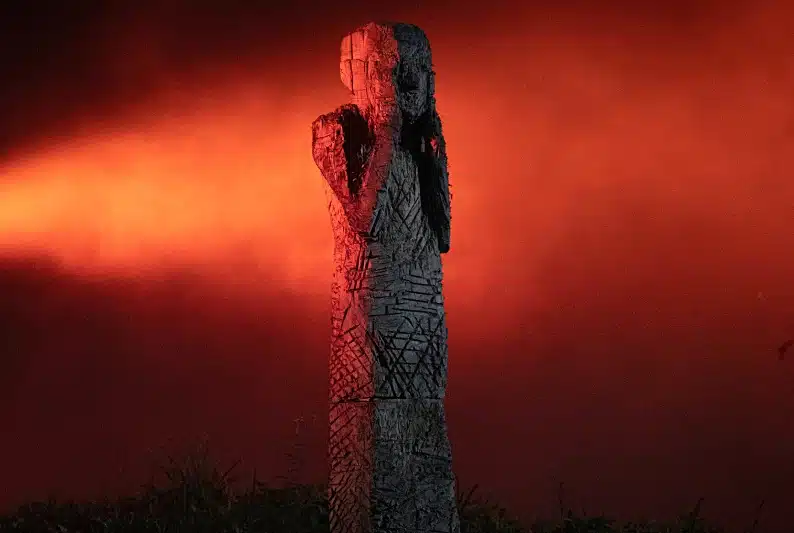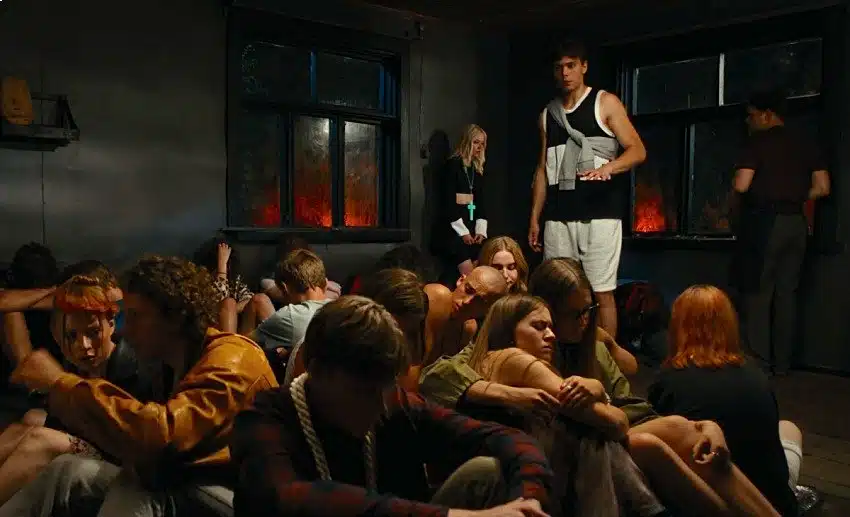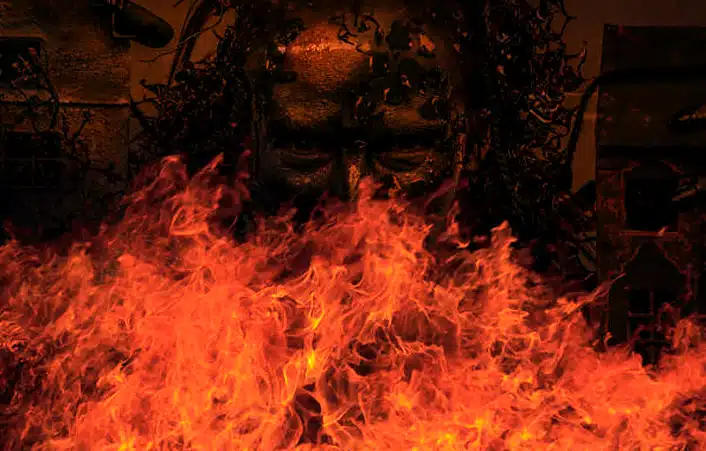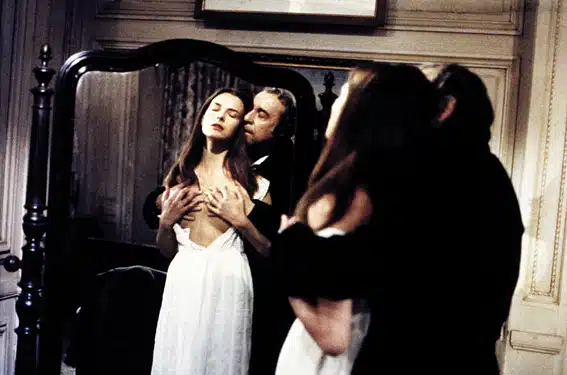words Christina Brennan
Teen slashers and horrors, including the Halloween, Friday the 13th, and Scream franchises, play off the idea that teenagers are likely to make bad decisions when a monster or masked killer is out for blood. Teen horrors often combine high body counts with gruesome humour and strict morality tales. If you’re a teenager and have sex in horror films, you die. If you don’t do your schoolwork, you die. If you drink and take drugs, you die.

Film director, Jonas Trukanas, based in Vilnius, Lithuania, has his own take on teen horror. His debut feature Pensive is a coming-of-age film that combines horror with a more human exploration of its teen protagonists. The film opens with a graduating high school class are celebrating at a remote woodland cottage. What begins as a party becomes a nightmare, starting when they encounter a large wooden sculpture of a man shrinking back in horror at the edge of the woods. Things become more ominous as they sense they are being watched by an intruder to their party. It’s a dark mash-up of teen horror featuring the masked stalker as its villain, with elements of eerie folk horror set in Lithuanian woods.
Pensive plays at FrightFest Glasgow 2023, an arm of the U.K.’s largest international thriller, fantasy, and horror movie festival. Christina Brennan sits down with Jonas to discuss directing Lithuania’s first slasher horror film and the future of horror within Lithuanian cinema.
This is your first feature film. Tell me about your background and how you came to be a director?
I trained in the UK and graduated in Film Directing from University for the Creative Arts in Farnham in 2012. During my degree, I made my debut short film Booksmuggler (2011), which won an Audience Favourite Award at Vilnius International Film Festival.
After that, I’ve been building my career by directing commercials alongside other short films, including Ghost Don’t Remember (2015), Trolleybus-Man (2016), and When the Lights Go Out (2018). I’ve been finding my voice while developing these projects. I’ve been trying to fund different longer feature projects for over five years which have fallen through due to funding and production. Pensive is the result of a lot of work and effort.
Can you tell me more about your interest in horror and your inspirations from horror?
When I was growing up, horror was not that accessible. So when I started watching horror films, at around twelve or thirteen, it felt very transgressive and taboo. I remember being drawn to the extremes of horror. When you start watching films as a teen, you may not understand why certain films may affect you, but you know that they appeal to your own fears.
Horror eventually became a source of community with other fans. I started to analyse horror and think through what different films meant for me and why different horrors are able to speak to and about different cultural and political contexts. One of my favourites is Alien (1979) and I remember the build-up to that film and hearing my friends talk about it (which enhanced my own fear and anticipation). I also love Friday the 13th (1980) and other slasher films, and I love horror of extremes, including Japanese horror.

Can you describe Pensive in a few sentences?
It’s folk horror focusing on a coming-of-age journey that reflects the current generation. We’ve hopefully produced a film that people should find relatable.
Pensive has been marketed as the first slasher in Lithuanian cinema. What is the history of horror in Lithuanian cinema?
There isn’t a long tradition in Lithuania. We don’t have traditions of popular genres, including horror and science-fiction. The first actual Lithuanian horror film came our 2008 or 2009. This film is called The Basement, and it’s a psychological film. There isn’t much of a precedent for horror in Lithuanian cinema. However, Lithuania has a robust arthouse scene, and perceptions of horror are changing in Lithuania as they are also changing in the wider film world. No one regards horror as a B-genre anymore due to directors including Ari Aster (Hereditary, 2018, and Midsommar, 2019) and Jordan Peele (Get Out, 2017, and Us, 2019). Horror isn’t just jump-scares, and it’s an evolving genre with many surprising elements and qualities.
Tell me about drafting Pensive’s script. How was that experience during the COVID-19 lockdown?
We spent about half a year talking about and writing the script. I worked with Titas Laucius, a brilliant director and a great writer. We met for nearly six months, about three times a day every day, to map out the context and characters. By the end of this process, we had an excellent idea of what we wanted the film to be. The writing itself was pretty quick. I wrote a speedy twenty-page treatment and finished it during one of the COVID-19 lockdowns. The lockdowns gave us a very focused environment to imagine and plan the film.
Pensive moves between teen/slasher horror and folk horror. Was this deliberate when writing the script?
We wanted Pensive to be a coming-of-age film with relationships rather than action at its core. The slasher film has a formula. It hasn’t developed much since The Texas Chainsaw Massacre (1974). It wasn’t our intention to mess with that formula. Instead, we wanted to balance this with the focus on the main character, Marius (Šarūnas Rapolas Meiliešius). He’s a pretty anonymous character at the start of the film. He’s on the day of his graduation, which is a pretty big deal in Lithuania since you spend twelve years in high school, and your adolescence is restricted to a narrow set of people. His classmates see him as relatively anonymous and boring, and he’s determined to change that image of himself. The slasher story overlaps with his character development throughout the film. I won’t say more than that at risk of spoiling the film. But I will say that his character arc is central to the plot in Pensive.

The cinematography is dark and brooding. It contrasts with some recent folk horrors that emphasise light and sunlight. Can you tell me about the decision behind that?
We had to think through the cinematography quite quickly. The film’s night-time setting is central to the film. We wanted to emphasise the danger within the film. We made select use of colour, including red, to foreshadow trouble and the potential danger that’s coming.
The film is also full of symbolism. Can you describe the symbolic figure at the heart of the film, the Pensive Christ? How important is that symbol in Lithuania, and what does the Pensive Christ mean within the film?
The Pensive Christ is a form of sculpture in Lithuania that marries Christian artistic tradition with folk and pagan art. You find them across villages in Lithuania, and they’re created to remind passers-by of the suffering of Christ on the cross. You can discover these sculptures randomly in the woodland and countryside in Lithuania. We wanted to refer to this tradition but didn’t want the film to have explicit religious themes. We also wanted to offer a more contemporary take on the Pensive Christ sculpture. The final image should convey suffering and pain and reflect the film’s deeper psychological themes.
Finally, what is coming next for you? Are there any upcoming projects that you can tell us about?
We’re in the process of writing a second feature that will be produced in the UK. I can’t say much, but I’ll give you an outline – it’s about a siren living in an aqua park and a father and son. We’re currently drafting the screenplay. I’m ready to experiment with other kinds of film.




